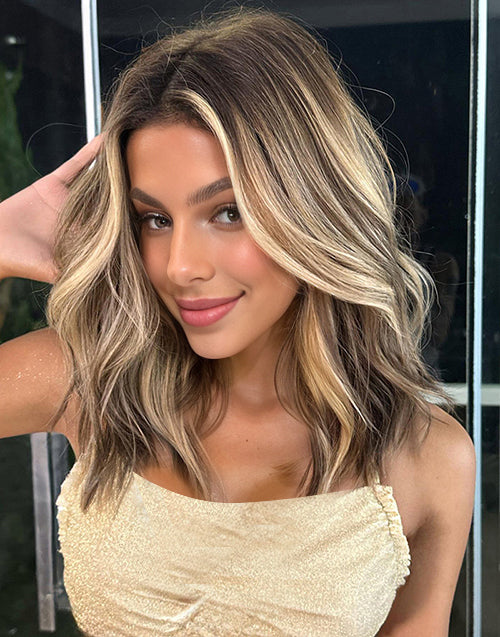What Is a Natural Color in Human Hair Wigs?
When shopping for a human hair wig, one of the first questions you might ask is, “What is a natural color?” Unlike synthetic wigs, human hair units offer the luxury of authentic shades that mimic real, unaltered hair. Yet within the spectrum of human hair, “natural” encompasses a range: from deep, rich blacks and browns to sun-kissed blondes, red hues, and the subtle variations in between. This comprehensive guide delves into what constitutes a natural color in human hair wigs—how they are defined, created, and selected—so you can make an informed choice for your next purchase.

1. Defining “Natural Color” in Human Hair
At its core, a natural color in the human hair industry refers to a shade that resembles the hair as it grows from the scalp without any artificial processing. Think of hair straight off the head of a donor before bleaching, dyeing, or any chemical treatment. In wigs, these colors are replicated to appear as authentic as possible. Importantly, “natural” does not mean a single flat tone. Real human hair exhibits depth: cooler undertones, warmer highlights, varied lowlights, and slight shifts in hue under different lighting. A truly natural shade captures those nuances.
When manufacturers talk about natural color, they often reference the International Hair Color Chart, a standardized 1–10 scale where:
Level 1 – Jet Black
Level 2 – Black
Level 3 – Darkest Brown
Level 4 – Dark Brown
Level 5 – Medium Brown
Level 6 – Light Brown
Level 7 – Dark Blonde
Level 8 – Medium Blonde
Level 9 – Light Blonde
Level 10 – Very Light Blonde
Within each level, there may be sub-categories describing undertones—for instance, 4N (neutral dark brown) or 7G (golden dark blonde). These designations help you identify a wig shade that closely matches your natural hair or the hair you hope to emulate.
2. Understanding Undertones and Tones
Beyond the numeric color level, natural hair has characteristics determined by its undertone (warm, cool, or neutral). Understanding undertones is crucial when selecting a wig that looks convincingly natural.
Warm Undertones: Hues such as golden, reddish, or tawny. These are often labeled with a “G” (gold), “R” (red), or “A” (amber) in the color code. For example, 6G is a light brown with golden highlights.
Cool Undertones: Ashy or smoky, with hints of green or blue. Marked with “N” (neutral) or “C” (cool). A 5N shade is a classic medium brown without obvious warmth or coolness.
Neutral Undertones: Balanced between warm and cool, making them versatile and complementary to many skin tones. These shades often blend seamlessly without appearing too yellow or too ashy.
Real human hair under natural light displays a rich interplay of these undertones. Manufacturers strive to replicate this by selecting donor hair that inherently possesses those color characteristics and minimal processing. When shopping, look for terms like “natural brown,” “neutral black,” or “ash blonde”—these signal a shade that closely mimics hair grown in its natural state.

3. The Spectrum of Natural Colors Available in Wigs
Human hair wigs come in an impressive array of natural shades. Below is a deeper look at some of the most popular categories:
3.1 Jet Black (Level 1)
Jet black is the darkest shade, almost void of visible highlights. Under bright light, subtle navy or blue undertones may appear. This color works beautifully for those seeking a dramatic, high-contrast look—often paired with lighter clothing or makeup to create a striking effect.
3.2 Natural Black (Level 2)
Slightly softer than jet black, natural black exhibits small hints of dark brown when illuminated. This shade is extremely versatile, flattering across various skin tones, and is commonly used as a base for customized coloring.
3.3 Dark Brown (Levels 3–4)
Dark brown offers a rich, chocolatey hue with warm or neutral undertones. Depending on the specific level, you may find hints of red, gold, or ash. This shade is a classic choice for those wanting depth without being as stark as black.
3.4 Medium Brown (Level 5)
Level 5 is the quintessential “natural brown”—neither too dark nor too light. It flatters most complexions and can feature subtle golden highlights for dimension. Medium brown wigs often serve as the foundation for balayage or highlight customizations.
3.5 Light Brown to Dark Blonde (Levels 6–7)
Light brown (level 6) transitions into dark blonde (level 7). Expect warm, honeyed tones in level 6 and cooler, faintly ashy hues in 7. These shades work well for sun-kissed, natural looks—perfect for summer or transitional seasons.
3.6 Medium Blonde to Light Blonde (Levels 8–9)
Medium blondes (level 8) show noticeable brightness but retain natural warmth. Light blondes (level 9) are almost platinum but still hold subtle golden or neutral undertones. These colors can look especially luminous in direct sunlight.
3.7 Very Light Blonde (Level 10)
Almost white, level 10 requires careful maintenance to avoid brassiness. In wigs, truly natural level 10 hair is rare—most genuine blondes at this level have undergone meticulous processing. Look for “naturalest blonde” labels to ensure authenticity.

4. How Manufacturers Replicate Natural Shades
Producing a wig in a convincing natural color involves careful sourcing and minimal processing:
- Hair Donor Selection: High-quality manufacturers source Remy human hair from donors whose hair has not been heavily processed. These donors often provide hair that remains in its natural state, preserving consistent cuticle alignment.
- Washing & Sorting: Donated hair is washed to remove impurities but not bleached or dyed unless creating a specific shade requires a minor adjustment. Technicians sort hair by length and color level, grouping strands of similar hues to ensure uniformity.
- Color Matching: Rather than relying solely on chemical dyes, many manufacturers mix small amounts of color to achieve a shade that mirrors natural variations—slight streaks, baby-lightenings near the ends, or a faint shadow at the roots.
- Quality Control: Samples are regularly compared under natural and fluorescent lighting to guarantee the wig shade appears authentic in all environments.
By minimizing processing—especially avoiding harsh bleaching—manufacturers preserve the hair’s natural integrity. This not only maintains the original color depth but also improves longevity: overly processed hair tends to tangle and break sooner.
5. Matching Wig Color to Your Natural Hair or Desired Look
Whether you want a wig that seamlessly blends with your existing hair or crave an entirely new shade, consider these tips:
Observe Natural Variations: Look at your hair in different lights. Is there a golden glow in the sun? Does it appear cool under indoor lighting? Select a wig that mimics those fluctuations.
Compare Undertones: If your natural hair is warm, avoid wigs labeled “ash” without supplemental warm highlights; they may look flat. Conversely, cool undertones can elegantly neutralize overly warm complexions.
Bring a Sample: When possible, bring a small section of your natural hair to compare directly against wig swatches. This is especially helpful for complexions that shift with seasons (e.g., summer tan vs. winter pale).
Consult Virtual Try-On Tools: Many retailers now offer augmented reality previews, allowing you to see how different natural shades look against your face before purchasing.

6. Popular Natural Wig Colors and Their Appeal
6.1 Jet Black & Natural Black
Ideal for high-contrast looks, jet black and natural black wigs deliver a rich depth that frames the face. These colors are popular among those seeking a classic, dramatic appearance. Black wigs pair beautifully with bold makeup or light-colored outfits, creating striking visual balance.
6.2 Dark Brown & Chestnut Brown
Dark brown wigs range from espresso to chestnut. Espresso infuses a cool brown base, whereas chestnut exhibits warm, reddish undertones. Both variations provide a natural look that suits most skin tones and can be styled in waves or sleek straight for versatility.
6.3 Medium Brown & Light Brown
These mid-level hues bridge the gap between dark brown and blonde. Medium brown often carries golden reflections, and light brown features honeyed highlights. These shades appear sun-kissed, making them especially popular for summer styles or boho-inspired looks.
6.4 Dark Blonde to Medium Blonde
Dark blonde (level 7) offers a muted platinum effect, while medium blonde (level 8) radiates brightness tempered by natural warmth. These colors suit those who wish to maintain a “just-out-of-salon” glow without full platinum commitment.
6.5 Light Blonde & Very Light Blonde
Light blonde wigs shimmer under direct light, often revealing hints of gold or platinum. Very light blonde wigs (level 10) verge on white. Maintenance is crucial—use purple shampoo to prevent brassiness and UV-protective sprays to avoid yellowing in sunlight.
6.6 Red & Auburn
Red wigs span from deep burgundy and auburn to vibrant ginger. Auburn incorporates both red and brown, achieving a sophisticated balance. Burgundy leans cooler with violet undertones. Ginger appears brighter and more orange. These shades stand out in a crowd, particularly against neutral wardrobes.
6.7 Strawberry Blonde
A delicate blend of pink-red and blonde, strawberry blonde wigs produce a soft, romantic aesthetic. This shade flatters fair to medium complexions, lending a youthful, sunlit look reminiscent of light catching strands.
6.8 Ash Brown & Ash Blonde
Ash shades neutralize warmth. Ash brown carries subtle gray undertones; ash blonde has a smoky, platinum-adjacent quality. These colors suit cool-complexioned wearers and provide a modern, edgy vibe.
6.9 Caramel & Honey Brown
Caramel wigs feature golden brown highlights that create dimension. Honey brown straddles the line between bronde and brown, offering warmth without appearing overly yellow. These shades catch sunlight in a way that mimics natural sun-bleached strands.
6.10 Chestnut & Chocolate Brown
Chestnut wigs glow with red-brown undertones, while chocolate brown appears deeper and cooler. Both provide a luxurious, glossy finish, especially when styled in soft waves that reflect light across each strand.

7. Customizing Natural Colors with Highlights and Lowlights
Even “natural” wigs often benefit from subtle customization. Highlights and lowlights—strands one or two shades lighter or darker—mimic the dimensional quality of real, sun-kissed hair.
Face-Framing Highlights: Lighten only the front strands around the face to brighten and draw attention to features.
Root Shadow Lows: Add a slightly darker shade at the roots to give a lived-in effect and elongate maintenance intervals.
Balayage/Babylight Techniques: Hand-paint very fine highlights for a graduated, natural fade from root to tip.
These methods ensure the wig looks like real hair that has grown out with natural light exposure, rather than a flat “one-color-fits-all” approach.
8. Matching Natural Wig Color to Skin Tone
To achieve a harmonious look, consider:
8.1 Identifying Your Undertone
Warm Undertones: Greenish veins, gold jewelry flatter warm colors like auburn and honey brown.
Cool Undertones: Blueish veins, silver jewelry suit ash brown and burgundy.
Neutral Undertones: Can experiment freely between warm and cool shades.
8.2 Testing in Daylight
Whenever possible, compare the wig shade to your natural hair or bare skin under natural daylight. Indoor lighting can distort tones and undertones.
8.3 Undertone Adaptation
If you fall between categories, choose a neutral descriptor—such as “natural brown” or “neutral black”—and allow slight variations in highlights or lowlights to complement your complexion.

9. Creating “Naturalest” Shades: Minimal Processing
True-to-life natural colors require minimal processing. Over-bleaching or heavy dyeing flattens out natural depth. When shopping:
Look for “Remy” or “Virgin” Labels: These indicate hair with preserved cuticles and minimal chemical alteration.
Avoid Excess Bleach: Bleached lace-front wigs often appear “overdone.” Seek wigs where the bleaching is limited to highlight sections only.
Trust Quality Brands: Reputable suppliers showcase clear color codes (e.g., 4N, 6G) and often provide multiple lighting photos for reference.
10. Maintenance Tips to Preserve Natural Color
Natural shades can fade or become brassy if not cared for properly, especially lighter blonds and reds. To maintain:
Sulfate-Free Shampoos: Gentle cleansers preserve cuticle integrity and color vibrancy.
Color-Safe Conditioners: Use formulas specifically designed for colored or virgin hair to lock in moisture.
UV Protection: Apply leave-in sprays with UV filters to prevent sun-induced color shifts.
Cool-Water Rinses: Hot water can strip natural oils and fade color; rinse with cooler temperatures to prolong vibrancy.
Regular Purple Rinse (for Blondes): Neutralizes yellow or brassy undertones in ash or light blondes.
11. Trending Natural Color Styles for 2025
11.1 Shadow Root Browns
Keeping roots slightly darker than mid-lengths adds realism and extends time between washes. Popular variations include level 3N roots transitioning to level 5N mids.
11.2 Subtle Balayage Blondes
Very fine, hand-painted highlights on a level 6 or 7 base create a natural, sunlit effect without harsh lines.
11.3 Deep Chocolate with Caramel Tips
A level 2N or 3N base gradually melts into level 6G or 7G tips for a warm, luxurious finish.
11.4 Natural Red Embers
Level 4R (medium auburn) infused with subtle 5R lowlights for depth; ideal for those seeking a rich red without looking overly artificial.
11.5 Muted Ash Blondes
Level 8A or 9A shades that avoid yellow tones, offering a chic, cool blonde that suits a range of skin tones.
12. Customizing Natural Colors with Accessories
Even a human-hair wig painted to a natural shade can be personalized with:
Scalp Tint Powder: Dust near the part line to blend lace and scalp.
Clip-In Light Streaks: Add removable highlights in warmer or cooler tones.
Subtle Root Concealers: For wigs with planned grow-out lines, conceal harsh edges at the part.
13. Natural Color vs. Bold Color: When to Choose Each
While natural colors offer timeless appeal and easy integration, bold shades—platinum, pastel, or vivid red—serve specific style statements. Consider:
Natural Colors: Best for daily wear, office environments, and achieving a classic look. They require less maintenance and have broad appeal.
Bold Colors: Ideal for special events, social media content, or personal reinvention. They demand more upkeep (root touch-ups, color-safe products).
14. Budgeting for a Natural Color Human Hair Wig
Prices vary by origin, length, and cap construction. On average:
Short (10–12") Natural Shades: \$150–\$250
Medium (14–18") Natural Shades: \$200–\$350
Long (20–24") Natural Shades: \$300–\$500+
Expect higher prices for rare donor shades—very light blonds or unique reds. Always verify return policies and color accuracy guarantees.
15. Ethical Considerations and Sourcing
Purchasing a “natural color” wig means trusting the supply chain. Look for:
Ethically Sourced: Ensure donors are compensated fairly and sustainably sourced.
Minimal Processing Labels: “Virgin” or “Remy” hair indicates the cuticle runs in one direction, minimizing frizz and tangling.
Transparency: Brands that reveal origin stories—whether the hair comes from India, Brazil, or another region—tend to offer higher quality and ethical standards.

16. Real-World Examples: Celebrities and Their Natural Shades
Celebrities often set trends by wearing human-hair wigs in natural shades:
Jennifer Aniston: Known for her “Rachel” streaks—a level 7 base with subtle lighter highlights.
Zendaya: Frequently sports a level 3N bob that frames her face with rich, dark brown hues.
Ariana Grande: Her signature ponytail often uses level 1–2 black wigs with natural sheen.
Observing red-carpet photos can help you gauge how natural shades translate from overhead lighting to camera flashes.
17. Common Misconceptions About Natural Wig Colors
“All dark wigs look the same.” False—two level 3 browns can differ significantly in warmth and undertone. Always review close-up swatches.
“Natural reds fade quickly.” While reds can fade if overexposed to sun or wrong products, using color-safe shampoos and UV-protectant sprays preserves vibrancy for months.
“Blondes can’t look natural in wigs.” Light blondes require skilled processing. Look for “naturalest blonde” tags and pictures under daylight to ensure authenticity.
18. Shopping Checklist for Natural Color Wigs
Before hitting “Buy,” confirm:
Exact color code (e.g., 4N, 6G, 9A) and accompanying photos.
Undertone description (warm, cool, neutral).
Cap construction details (lace front, monofilament, etc.).
Return/exchange policy for color mismatches.
Origin and processing claims (Remy, virgin, ethically sourced).
19. Transitioning Between Natural and Customized Shades
Many wig wearers start with a natural base and gradually experiment:
- Start with a Neutral Base: A level 5N or 6N gives you room to add highlights or lowlights later.
- Add Subtle Highlights: Use clip-in highlights or partial balayage to test before committing to a full color.
- Consult a Stylist: For major changes—like jumping from brown to blonde—seek professional toning to avoid brassiness.
20. Conclusion
Natural colors in human hair wigs span a broad spectrum—each level and undertone carefully crafted to replicate hair straight from the scalp. By understanding color levels, undertones, and the manufacturing process, you can select a shade that complements your complexion and lifestyle. Whether you desire the richness of a deep chestnut, the sunlit glow of honey blonde, or the edgy contrast of ash brown, natural wigs offer authenticity and versatility. Armed with these insights—on matching skin tone, minimal processing, and maintaining vibrancy—you’re ready to choose and care for your perfect natural color wig in 2025.
People Also Ask
How do I know if a wig color is truly natural?
Check the color code, undertone description, and compare multiple lighting photos. Look for minimal processing labels like “Remy” or “virgin.”
Can I dye a natural-colored human-hair wig?
Yes—human-hair wigs can be colored by professionals, but start with minimal processing to preserve cuticles.
How often should I wash a natural-colored wig?
Wash every 8–12 wears with a gentle, sulfate-free shampoo; use UV protection to prevent color fading.

























Leave a comment